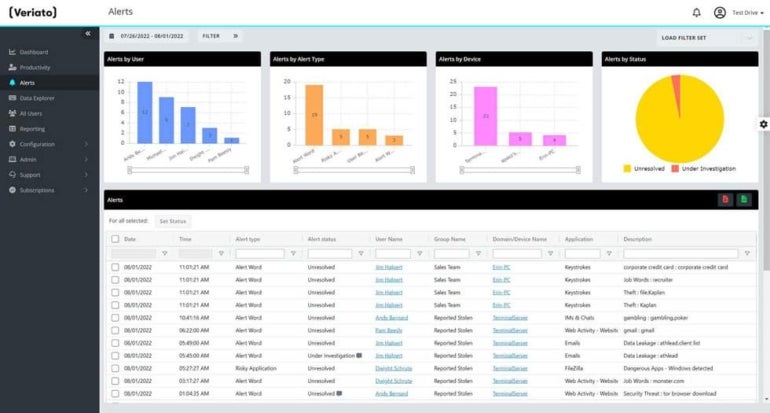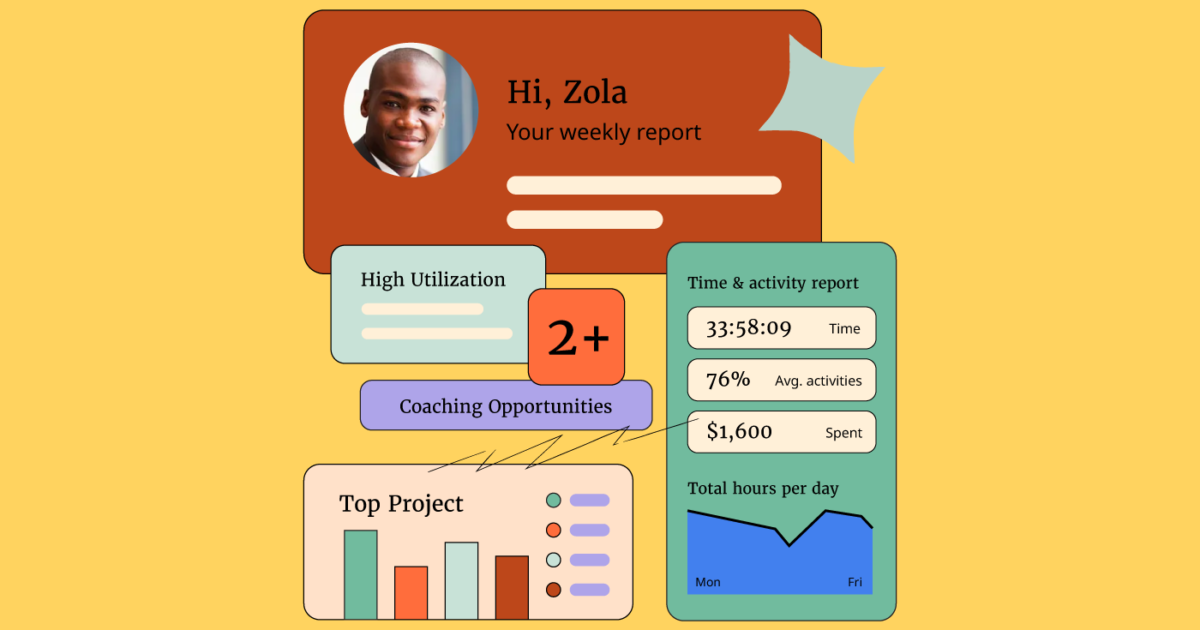Software for monitoring employees is a software that businesses to monitor and track employees' activities. It lets employers collect information regarding various aspects of employees' behavior, such as internet use and application usage. Keystrokes can also be tracked as well as screen shots. Software to monitor employee activity is primarily used to boost productivity, ensure the compliance of company policies, safeguard sensitive data as well as address security concerns. When choosing an employee monitoring software, there are many things to think about. These are the main points to keep in mind: Features- Decide which features your organization needs according to your needs. The most popular features include activity monitoring and website blocking. Other features include keystroke logging and tracking software including email monitoring, and reports generation. You should prioritize only those features that are pertinent to your monitoring requirements.
Compliance and Privacy - Make sure the program complies to ethical and legal guidelines in relation to monitoring of employees. Make sure you are familiar of any applicable laws or regulations, including privacy and data protection laws. You should look for software which has clear and customizable features that protect the privacy rights of employees.
User-Friendliness: Consider the software's ease of use and accessibility. A user-friendly interface and straightforward set-up process can save you time and simplify implementation. Find customizable dashboards and intuitive reporting tools that let you easily browse and analyze the information you've collected.
Integration and compatibility - Make sure your application is compatible with the current IT infrastructure and the systems you are using, such as email clients and collaboration platforms, as well as project management tools, and operating systems. Compatibility ensures seamless monitoring without disrupting day-to-day operations.
Data Security- Examine the software security measures in order to ensure the security of the data you collect. Access controls and encryption as well as secure storage of data and compliance to industry standard security protocols are essential. Verify that the software company is able to protect your data and has solid security protocols.
Scalability- You should think about the software's scalability to accommodate the growing needs of your company. If you're looking to expand your staff or establish new locations, you should choose a software that can be easily adjusted to meet the needs of your business.
Analytics and Reporting - Look at the features of the software that allow reports. Find features that offer complete information on employee productivity, time allocation, and trends. Customizable reports and analytics aid you in making informed decisions and determine areas of improvement.
Customer Support - Assess the quality of customer support offered by the vendor. Examine the availability of their technical support and also. A good customer support team will provide prompt assistance to any issues that may arise.
Cost- Take a look at the pricing structure of the software. Is it a single payment, a monthly subscription or based on usage? Know the price, and if there are additional charges for support, upgrades or other features. Make sure you are budgeting in line with the value and features provided.
Transparency and Employee Communication - Communicate clearly with your employees on the introduction of software for monitoring. Transparently communicate the purpose and scope of work and the expectations regarding the monitoring. Discuss any concerns that they might have, as well as assure them of respect for their privacy.
Consider these factors to make a well-informed decision. Choose the employee monitoring software that can meet your business' needs while respecting employees' privacy. View the top rated time tracking monitoring service company for blog info.

What Are The Strengths And Differences Of Software For Tracking Employees?
The software comes with a wide range of features that permit you to monitor and analyze the activities of employees. Monitoring software for employees can have diverse features. Here are a few most commonly used features. Activity Monitoring This feature records and logs all employee activities such as the websites visited, programs used, files accessed and time spent. It gives a complete overview of the time that employees spend working.
Keystroke Logging Keystroke Logging Keystroke recording records each keystroke that employees type. It can help find bottlenecks in productivity, identify unauthorised activities, and gather evidence to support investigations, if required.
Screenshots or Screen Recording - Some software takes regular screenshots from computer screens, while other software records their screens in real-time. This feature can be useful in monitoring productivity, ensuring compliance, or troubleshooting issues.
Internet Usage Tracking This function records employees' online activities, including searched for websites, visited sites, downloads, etc. It allows you to identify non-work related browsing security threats or policies that are not being followed.
Application Usage tracking - This feature tracks applications used during work hours by employees. It can help identify inappropriate and excessive use of apps by providing insights into the applications frequently used.
Email Monitoring: Employers can check the content of emails received and sent by employees, as well as attachments, as well as the contents of emails. It's a great method to enforce policies of the company, protect data, and uncover suspicious activity.
Monitoring of documents and files - This feature allows you to track file modifications transfer, access, and modifications. It can help protect sensitive information and monitor collaborative work on documents, and ensure compliance to privacy policies for data security.
Remote Monitoring is a feature which allows employers to keep track of their employees, even if they work from a distance or at various places. Employers can monitor their work and monitor the efficiency of employees regardless of where they are.
Productivity Analysis Monitoring software for employees has the ability to analyze productivity. These features reveal patterns in employee of work, time allocation and productivity levels. These analyses help identify areas of improvement and help optimize workflow.
Reporting & Analytics- Robust features for analytics and reporting produce detailed reports based on collected data. These reports offer valuable insight into the performance of employees in resource allocation, as well as time management.
Software that offers features for compliance and policy management can help ensure that an organization's guidelines and policies are followed. They allow employers to define and enforce rules pertaining to acceptable computer usage as well as internet access and security of data.
Alerts and notifications- Alerts or notifications notify managers or employers about specific situations or actions. They can be used to warn you of suspect behavior, for example, excessive use of the internet or attempts to gain access to restricted sites.
The availability and functionality of the features can vary between different employee surveillance software solutions. When choosing software, consider the features that match your objectives for monitoring and conform with the ethical and legal standards in your jurisdiction. See the best time tracking monitoring service company for site examples.

What Is The Compliance And Privacy Law For Employee Monitoring Software?
Monitoring software for employees must adhere to laws regarding privacy and compliance. While the exact legal requirements for compliance can differ based on the jurisdiction but there are a few common ways employee monitoring software conforms to privacy and compliance law. Consent & Notice- While many states require employees to give informed consent as well as be informed prior to any monitoring activity. The software used to monitor employees usually has options that permit employers to clearly communicate their monitoring policy to employees. This can be done through the use of written notices sent to employees, getting their permission using consent forms or creating a handbook outlining monitoring practices.
Transparent Monitoring policies- Employee monitoring programs promote transparency because they make sure employees understand the type of data that is collected, the purpose for monitoring is and what extent monitoring activities are carried out. The clear and complete policies will aid employees in understanding the limits of monitoring and their privacy rights.
Data Minimization Principles- Employee monitoring software often employs data minimization principles to comply with privacy laws. It means that only the required data is collected and retained. Data that is irrelevant or overly large are discarded. By limiting data collection to what is necessary for monitoring purposes This software minimizes the risk of privacy and increases compliance.
Anonymization and Aggregation Various employee monitor software anonymizes and aggregates data for further protection of employee privacy. Anonymization eliminates all personally identifiable data (PII) and makes it impossible to link data to individuals. Data from several employees are combined to provide insight into the group without identifying individuals.
Secure Data Store and Encryption Software for monitoring employees puts the security collected data first. It uses methods for secure storage of data and encryption to protect collected data against unauthorised access, breach, or accidentally disclosed data. This means that data is secured both during transit and in storage.
Access Controls and Restricted Permissions Software for monitoring employees offers access control with greater granularity to ensure compliance. Employers are able to limit access to monitoring data only to those who require it legally, such as HR employees or administrators.
Employee Rights: The right to respect employees' rights is essential to comply with privacy and compliance laws. Software used to monitor employees often has features that let employees access their monitoring information as well as request corrections and file complaints. It allows employees the right to seek recourse in the event of a privacy violation, and also make use of their rights.
Compliance with Data Protection Regulations - Employee monitoring software was created to be in compliance with regulations governing data protection, like the General Data Protection Regulation in the European Union (GDPR) or the California Consumer Privacy Act in the United States (CCPA). In order to comply, you must take the appropriate measures to protect privacy rights of data subjects as well as guarantee lawful processing.
Apart from employing employee monitoring tools, organizations should consult legal experts and stay current on laws and rules in their area of responsibility. Privacy and compliance laws demand a comprehensive strategy that includes more than just software. It also calls for clear policies, regular monitoring of compliance, and ongoing education. Read the most popular time tracking monitoring service company for site recommendations.
